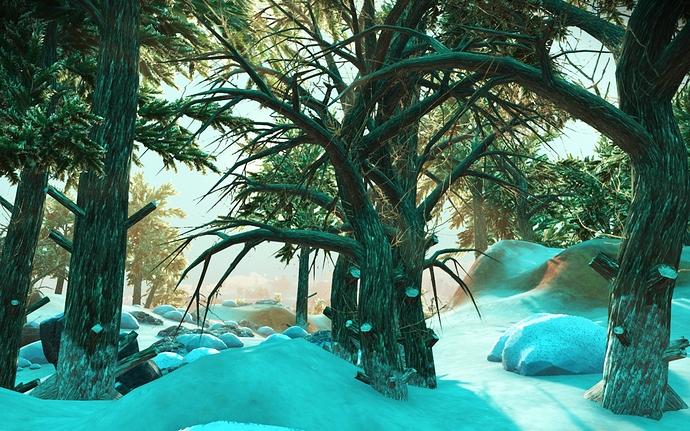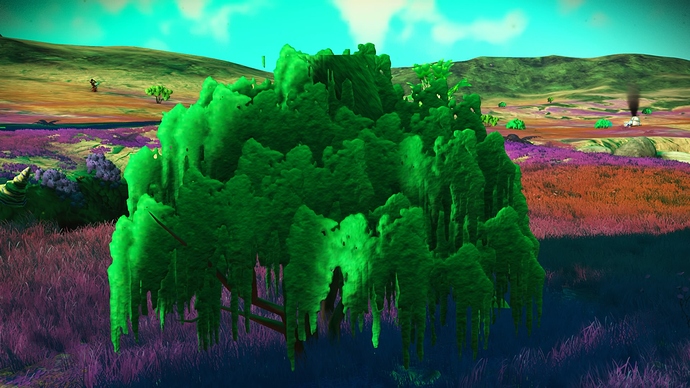Crap. Hope I didn’t just flag you. Bumped my tablet accidentally. Sorry. ![]()
I am not really worried, but you should be able to see this at the bottom right of the post (blue) in case you truly did.
I think I bookmarked it lol ![]()
This being the Citizen Scientist Division, I personally appreciate it when y’all link your sources (Like @DevilinPixy has) Thank you. That is all. ![]()
Almost feels like a forest in Skyrim…awesome!
Now if they would do something to fix these ugly things:
These are definitely an improvement but the leaves move in bunches and there’s a kind of kaleidoscope effect that’s hard to look at:
This! I would like to see “real” forest, for which one need at least 15 minutes walking on foot to cross it!
Today’s “forest planets” or “jungle planets” poses separate trees only.
Bests small forests are on frozen planets only, according to my 600 in game hours and 300 visited systems experience.
Yes. So far, frozen planets have become my favorites. Some of them are very pretty, especially at night with the flashlight on. ![]()
My main point was in the meaning of “spawn.” As long as one understands that in No Man’s Sky “spawning” is not actually bringing something into existence, OK. But that’s really a misuse of “spawn.” Existence arrives as soon as Hello Games seeds a universe. What some call “spawning” is really just display of what’s already in existence. Some games have true spawning; not No Man’s Sky. It’s a different concept than many games – even ProcGen ones–, so some confusion is understandable I guess.
In many games, such as mmorpgs, players will camp the “spawn” point of certain creatures. They kill the monster, then wait for it to “spawn” again, meaning the game renders it in again in the same exact spot.
And yes, creatures in NMS respawn as well. If you kill a creature, leave the planet and come back to it, the same creature will be back in the same spot.This is contrary to what SM said in an interview, but trust me, I have seen it happen many times. The creatures around my bases are always returning, even if I have killed them multiple times.
That is what video game players refer to as “spawning” by and large, a monster or other object being rendered in again in its pre-determined location. In fact, almost no game renders objects in “random” places, they are all pre-set with few exceptions.
Perhaps with the only difference being the Sentinel Walkers.
They come out of nowhere having been triggered by a player and do not re-appear if you leave.
I agree that all things in NMS are seeded and spawn upon your arrival, in that they become constructs in your visible range. They appear therefore they ‘spawn’ in the generally accepted game sense of the word.
However, the Sentinel walkers do simply appear. They were not already there and you upset them into attacking like little sentinels do. They spawn as a direct reaction to your players activities.
Unless they are floating around and invisible until they are triggered, they seem an accurate interpretation of the literal terminology of Spawning. No specific location other than the edge of your interactive range and never from the same direction.
Wouldn’t that qualify as a ‘random location spawn’ and thus qualify as a true spawn?
I completely concur. In NMS, we do not see any real “spawning points” for creatures as we see in other games. I think this is a true testament to the procedural generation that the game delivers. This is something that the game delivers over the course of worlds that has me exploring the nuances time and again to find the rare treasures.
Also, they cannot despawn, as long as they are within your range of vision. If you escalate a sentinel fight to the point where walkers spawn, then go and hide somewhere for long enough, or enter a building, the walkers will cease to be aggressive, and wander off.
When they get a certain distance from you (theoretically the limits of your vision), they despawn, and disappear from the game completely.
However, if you follow them, and keep them well within your range of vision, they can’t despawn. I’ve followed them for miles doing this. They will wander forever.
I kind of hoped they would lead me to some sort of base, or at least a significant area, but they don’t. They just wander aimlessly, until you lose sight of them, then they disappear.
Oh, and if you’re following a wandering non-aggressive walker, it’s a bad idea to attack it. If you do, the game will immediately spawn sentinels, dog robots, and up to three walkers. Even in an exocraft, you’re unlikely to survive.
Actually, I think the white dots you see when you use your analysis visor are the spawn points, which will render in the creatures if you get close enough.
Wow. This is exciting news! I’m eager to know how we “tag” a creature so that we know it’s the same exact one we killed. That would also be a boon to xenobiologist players who would like to track creatures, not just kill them. The technique may have many other uses.
There is a giant dog-lizard creature right next to my base in Survival Mode. I have killed him several times for the 20 mordite and he always is back later in the exact same spot.
When we are talking about ‘spawning’ in terms of games, this basically means a child process is executed to make an ‘object’ exist in the game. This child process to spawn an object is called according to a predefined set of rules and will continue to execute as long as these rules apply. The object is usually predetermined; looks, pathing, animation, and whatever else. The child process will render the object into existence in the game world, whether made visible or not.
Seeding is just predetermined rules to specify a certain outcome when that part of code using a ‘seed’ is being executed. You can consider a ‘seed’ to be a variable used in code to determine a specific outcome. Changing the variable, will result in a different outcome, similar to making changes to code in general. Basically with every game, the full world already exists in a way, prior to even running the code. Existence, in terms of code in general, means that part of code that is currently being executed. It is the full code of a game that will determine the outcome and full potential of what we as a player experience. For a player in a game, only a very small part of the full gaming world, truly needs to exist. It is limited to what is required for the player to funtion and see what is required to be visible. Therefor only a small part of the full code is actually being executed at any given time. Everything else does not actually ‘exist’ for the player, nor is everything already being exectuted in terms of code. Only once required and called for is it being brought into existence (executed). This is to ensure performance is as good as it can get, while attempts are made to make it appear as if all exists at once.
When I refer to ‘spawning’ a creature, I refer to executing a part of code to make its existence happen. In No Man’s Sky, creatures do not already exist just to be made visible. This is exactly what I have been trying to show you. If it were only about making a creature visible, I would certainly not call it ‘spawning’. However, in No Man’s Sky, a creature truly does not exist prior to calling its code to make it so, which includes making it visible as one of the many steps in this child process being executed. Was this creature already present in code? Yes, of course it was, but in a way no different from any other game. It does however only truly exist for us as a player, once that bit of code is executed to call for its existence as well as being made visible. Once the rules and conditions for this child process no longer apply, the code that determined its existence no longer executes. In case of No Man’s Sky, the creature stops to exist, the object instance is actually ‘destroyed’, no reference is created or stored. If this was the case, we would actually have been able to make it re-appear, by calling for this specific reference to the object instance, to just make it visible again. Instead, it executes the child process all over again to create a ‘new’ instance of the same object, according to its predetermined rules. Which is why I showed the video, to proof how the object is actually being ‘destroyed’. That specific instance of the object no longer exists.
Or perhaps the ProcGen rules have that area listed as one that attracts that type creature and that creature’s rules of behavior attract it to that area and also limit the number of such creatures that are in the area. It doesn’t require true “spawning” too account for such observations. If you see a creature “pop in” out of nothing, I’d report that to Hello Games as a bug. I have not seen such behavior.
Part of the problem in this discussion is separating math formula discussion from game discussion. The definition relates to code and formulas. It does not relate to gameplay and a game “universe.”










